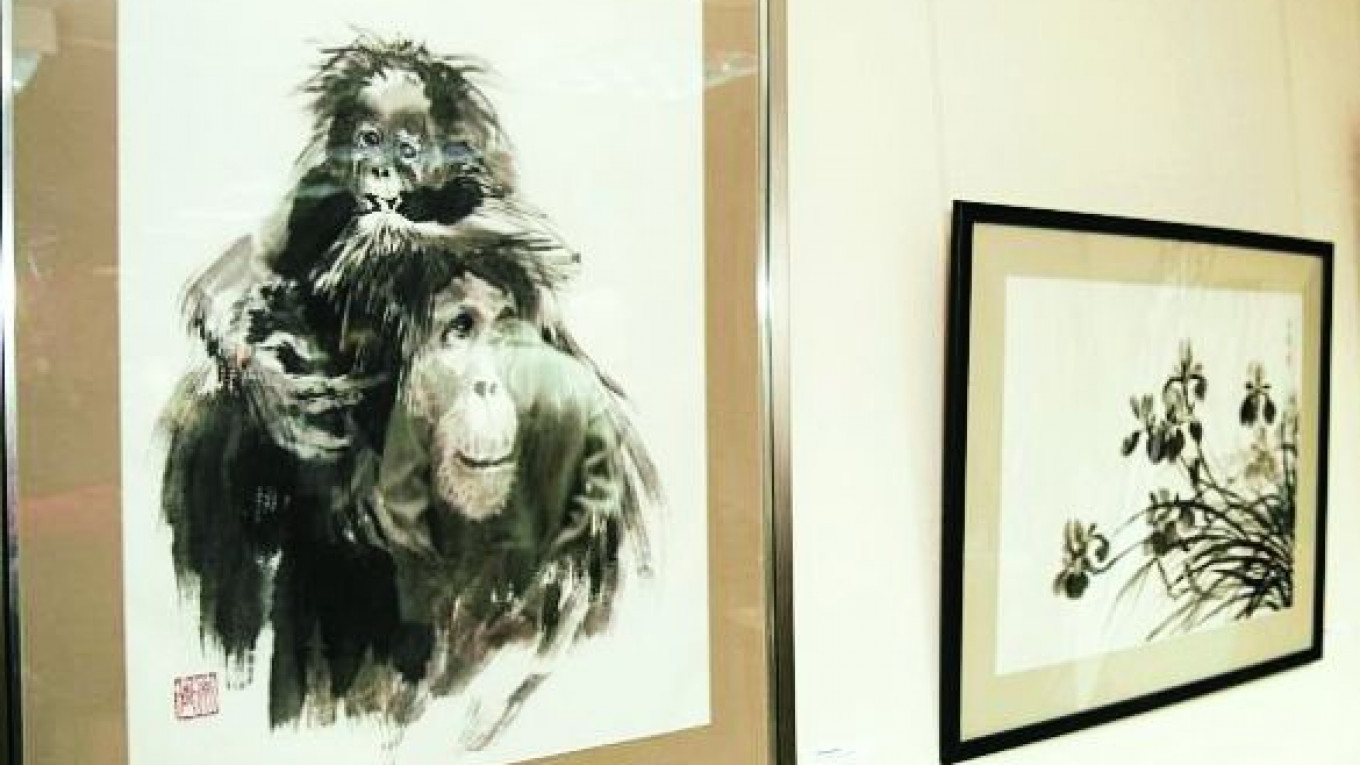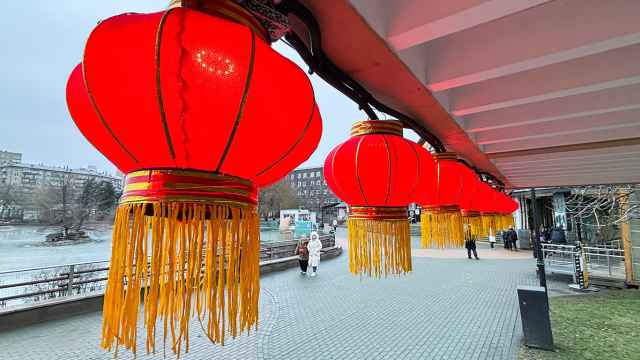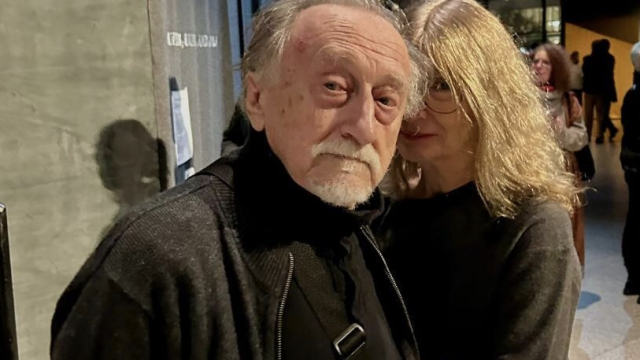Natalia Bezvulyak paints silence.
The Russian native specializes in Suibokuga, an ancient Japanese black-ink painting style, where a third of the picture is white space meant to be filled by the viewer's imagination.
It is hard to explain with words what it feels like to find yourself looking at a painting where the emptiness between the lines in the picture plays a more important role than the lines themselves and the silence is more important than the words. The very nature of creating artwork in the Japanese style is unusual, but Bezvulyak manages not only to adopt this style but also to mix in some Russian flavor.
"Masters of Japanese painting appreciate Russian identity in Japanese art," she said in an interview. "It is interesting how we communicate in the language of art, through ink, and add the Russian feeling of the beauty of nature, architecture and history."
Bezvulyak's Suibokuga works are currently featured in the exhibit "Vse Tsveta Chyornogo" (All Colors of Black) at the Novy Akropol. The artist has received praised from fellow Russians as well as the Japanese for her art.
The Japanese Embassy is one of the supporters of such art projects and invites artists, including Bezvulyak, to hold master classes for other Russians.
"The Japanese are very serious about what we're doing here in Russia. They are very interested in how their art develops in other lands. In Japan they consider with much attention the works of Russian Sakura-Kai [Cherry Blossom Society] members that we send annually to Japan's national art competition on Suibokuga," said Bezvulyak, who herself has received two awards in this competition.
Suibokuga, also known as Sumi-e, is a black-and-white painting style that originated in China around the Tang Dynasty, which spanned three centuries from 618 AD. It has a very sophisticated meaning: to capture a fleeting moment. The ink is the base of the picture, but the author always leaves white spaces that the viewer has to fill in on his own.
The uniqueness of this type of painting is that the artist can instantly capture his emotions on the canvas. The painting itself is a single continuous process that takes from 30 minutes to 1 1/2 hours.
For Bezvulyak, the most difficult thing in the painting process is to capture the mood. Sometimes waiting for the right moment of concentration takes a long time, but the result is not always positive, she said.
"The degree of satisfaction with my work depends on how well I was able to convey the feeling that I had at the time when I conceived the scene," she said. "My teacher taught me, 'Your picture is the movement, the way, so it cannot be completed.'"
During the study, a moment comes when the teacher determines that the student can submit his pictures for exhibitions and competitions. At this point, the artist receives a creative name.
Bezvulyak received her creative name, Nasei, from her teacher Olga Selivanova. The first character refers to her name Natalia and the final part comes from Selivanova's creative name.
Before she became Nasei and started to paint pictures in the Suibokuga style, Bezvulyak finished an art graphics program at the Moscow State Pedagogical Institute and trained for eight years in Chado, the art of the tea ceremony. This training, though seemingly unrelated, was nonetheless crucial to becoming a Suibokuga artist.
"All of the arts in Japan have a deep connection and similar laws. My progress in drawing is based on what I learned in the tea ceremony," Bezvulyak said.
In learning the art of the tea ceremony, the student masters Japanese manners and customs and amasses an extensive knowledge of traditional art and history. For eight years, Bezvulyak's teacher was Nisakagava Sotoku, who came to Moscow in 1991 to open Urasenke, a Japanese school of tea art at Moscow State University.
At the same time, a group of artists led by Midori Yamada Sensei founded the Sakura Kai society in Moscow for those who enjoy and want to learn the art of Suibokuga. Bezvulyak later joined it as well. In 2011, this society celebrated its 20th anniversary and now has more than a hundred members.
Learning to serve tea and draw "Japanese-style" took some adjusting to, Bezvulyak said.
"Having started to study the Japanese system, I realized how much of a difference there is between the Russian and the Japanese process of learning," she said. "Learning in the Japanese way is all about practice and experience. The teacher doesn't explain anything during the class, and you can't write down any notes. Your body, not your mind, has to remember the way to act and feel."
The process also takes a very long time. In Japan, to be able to independently conduct the tea ceremony, you must study for 10 years. To professionally brew tea, you study for eight years.
In Japanese art — whether for tea brewing or Suibokuga — there are always multiple levels of meaning, the painter said .
The higher the artist's level, the more layers of meaning are embedded in his painting. The same formula can be applied to the audience: the more prepared the audience, the more ways it can find to perceive the artwork.
Victor Mazurik, an associate professor of Japanese philology, equated the task of explaining the essence of Japanese art to holding a lecture on how to balance on a bicycle.
"Doing that would be long and confusing," he said. "But if you're put on a bicycle, you understand everything without explanation. The most valuable things are unspoken."
The exhibit "All Colors of Black" runs until Feb. 17 at Novy Akropol, located at 29/1 Ulitsa Usachyova. Phone: +7-917-534-1693. www.newacropol.ru.
Contact the author at artsreporter@imedia.ru
A Message from The Moscow Times:
Dear readers,
We are facing unprecedented challenges. Russia's Prosecutor General's Office has designated The Moscow Times as an "undesirable" organization, criminalizing our work and putting our staff at risk of prosecution. This follows our earlier unjust labeling as a "foreign agent."
These actions are direct attempts to silence independent journalism in Russia. The authorities claim our work "discredits the decisions of the Russian leadership." We see things differently: we strive to provide accurate, unbiased reporting on Russia.
We, the journalists of The Moscow Times, refuse to be silenced. But to continue our work, we need your help.
Your support, no matter how small, makes a world of difference. If you can, please support us monthly starting from just $2. It's quick to set up, and every contribution makes a significant impact.
By supporting The Moscow Times, you're defending open, independent journalism in the face of repression. Thank you for standing with us.
Remind me later.






